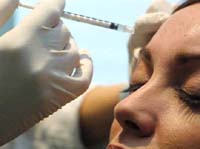Rejuvenating effects of Botox develop psychological dependence on the wonder drug
These days even grannies have heard a couple of things about Botox, a popular non-surgical injection that reduces frown lines. Not unlike any other wonder drug, Botox is wrapped up in a veil of myths, rumors and scary stories made up by people who either overreact or tend to speculate on things they have very little knowledge about.

Misconception No1: Botox injections distort a facial expression
Some psychologists believe that a person will flash a phony smile if the crow’s feet near her or his eyes are removed by a Botox injection. Those psychologists argue that a patient is likely to experience difficulties in terms of communication. On the other hand, does a child’s smile seem phony to you? A child’s face normally has no frown lines at all.
According to specialists in Botox treatment, facial expressions can be distorted only in case of an overdose or misdirected injection of the drug. Those who want to look ten years younger are strongly recommended to use services provided by certified plastic surgeons. Botox injection procedures performed by beauty parlors or home-based charlatans may result in dire consequences.
Misconception No2: Botox injections are toxic
Indeed, Botox is a mild cosmetic solution of botulinum toxin, the very toxin that causes botulism, a serious form of food poisoning. The above toxin thrives in improperly preserved foods, typically canned raw mushrooms or meats. The toxin selectively affects the central nervous system.
The safety of Botox is ensured by its pinpoint administration i.e. the drug is injected into a a certain muscle or a group of muscles. A Botox injection is simply incapable of spreading its action outside the given area due to a very low concentration of the toxin in the drug. The right dosage of a drug injected in a professional manner is the cornerstone of safety.
According to physicians, aspirin and antibiotics are potentially more harmful than Botox.
Misconception No3: a patient develops an “addiction” to Botox injections
The drug does not give rise to any physiological addiction. Besides, the effects of Botox treatment are not permanent, reportedly lasting from three to six months.
As for the psychological dependence on Botox, a person will certainly look and feel younger and more attractive as the skin gets smoother and the wrinkles are gone for some 3-6 months following Botox treatment. Needless to say, a person cannot but love the new look and the way she or he feels about it. Yet the rejuvenating effects are temporary, and a person simply does not want to see those unsightly crow’s feet on her or his face again when Botox stops working. Should you go for another injection? Does your desire to look good mean psychological dependence in disguise? It is a rather philosophical question.
Misconception No4:Botoxinjectionsare a stressful experience to the muscles
In actuality, things are entirely different. We laugh, cry, and make a face while our facial muscles keep working. We are often unable to unwind and let our facial muscles relax even when we are asleep. Tension and fatigue build up as years go by.
We work overtime, we skip a vacation for two years in a row, and one day we feel like screaming out loud because we cannot take that tension anymore. In the meantime, our facial muscles have been working overtime for years. So why not give them a break?
A Botox injection is a means to make the muscles relax for awhile. What stress has to do with it?
Misconception No5: Botox injections are a painful experience
They say getting a shot of Botox really hurts. On the contrary, it is totally painless. No unpleasant sensations before, in the middle or after a pinprick. Those who were given Botox injections compare their sensations to those experienced during a mosquito bite. Besides, a physician applies an anesthetic cream to the face of a patient and also holds ice to the site of an injection.
A tiny bruise may form on the site of an injection sometimes. As a rule, there is no bruising at injection site.
Misconception No6: Botox injections should be administered only to persons above 40
According to physicians, Botox injections can be applied to persons of 18 years of age and onward provided there is a real need for getting a “shot of beauty.” It is an open secret that teenagers sometimes develop severe mimic lines.
It is a lot easier to tackle a problem at its early stage. So why not treat the lines before your skin loses its smoothness with age? Besides, the older you are, the more difficult it would get for your skin to get used to the effects of Botox treatment. You will probably need to treat your face to additional cosmetic masks and massage.
Misconception No7: Botox injections are good for facial lines only
The physicians started using Botox for treatment of a number of neurological disorders prior to using them to eliminate or reduce the so-called furrows or frown lines. In fact, the physicians discovered the cosmetic effects of Botox in the process.
Botox has also been used to treat other dystonias, such as writer's cramp, as well as facial spasms, head and neck tremors and hyperhidrosis (excessive sweating). A recent study has even been conducted to observe its use in treating chronic neck and back pain. Botox is successfully used to treat blepharospasm, strabismus, and cervical dystonia – these are the conditions that in some way involve spasms, involuntary muscle contractions.
Medportal
Translated by Guerman Grachev
Pravda.ru
Subscribe to Pravda.Ru Telegram channel, Facebook, RSS!


